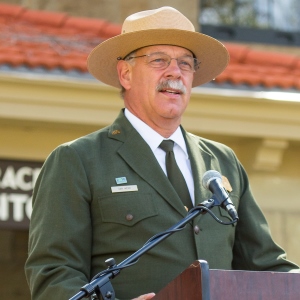Superintendent
Yellowstone National Park
 Responsibilities:
Responsibilities: “Ensure the mission of the National Park Service — preserving resources balanced with visitor use and enjoyment — is followed in Yellowstone and make sure Yellowstone has the staff, financial resources, and facilities appropriate for the task. It’s like being chairman of a multi-faceted corporation whose stockholders are the American public. Each day, I try to figure out ways to pass it on to future generations and not screw it up. But it’s the best job! I work at the world’s first national park. Yellowstone is at the forefront of issues related to natural and cultural resources. It’s an opportunity to make a difference in what conservation will look like and how parks are managed into the future.”
Years in current position: 6
Years with the Park Service: 41
Career path: Wenk joined the National Park Service as a landscape architect in the agency’s national planning, design, and construction management office in Denver, Colorado, which is called the Denver Service Center. Later he served as park landscape architect at Yellowstone National Park, superintendent of Mount Rushmore National Memorial, director of the Denver Service Center, and deputy director of NPS operations in Washington, DC, before returning to Yellowstone National Park as superintendent.
What makes my park special: Yellowstone was our first national park, established in 1872 to protect its geysers (which account for about half the world’s active geysers). As western land development increased, the park also became a sanctuary for the largest concentration of wildlife in the lower 48 states. It forms the core of the Greater Yellowstone Ecosystem. “The bison herds in the Lamar Valley are similar to [what you would find in] the early 1800s in the West. You can watch how natural systems function, such as prey-predator relationships when a pack of wolves takes down an elk. And there are 5- to 10-pound, 25-inch fish. I don’t know anywhere else like it on this scale.”
Typical day: Wenk says there’s no such thing as a typical day. His work day could include “budgets, visitor safety, reports, meetings with our affiliated native tribes and Friends organizations, concession contracts, law enforcement . . . . ”
Biggest challenge: “Wildlife doesn’t respect boundaries. They migrate in and out of the park.” The challenge is finding common ground among groups with different priorities. “We as a society have to be willing to make the kinds of decisions that will protect places like Yellowstone and the public lands around it.”
Best part of the job: “Experiencing the park, especially watching visitors’ reactions. I love sitting on the brink of the Upper Falls and seeing how it captivates them.”
Advice for visitors: “Think about what experience you want before you get here. In winter, there are more opportunities to be alone and be emotionally renewed. In spring, you can see the birth of bison calves and bear cubs. In summer, you have to be a careful planner due to the crowds. It might take 45 minutes to drive 14 miles due to an “animal jam.” In fall, the weather is best — cool, crisp days — and with the migrations from the high country to lower elevations, there’s so much to see with fewer crowds. You can experience Yellowstone on Yellowstone’s terms.”
Favorite national park: “Yellowstone National Park. It holds a special place in the hearts and minds of people — not just here but all over the world.”
Learn more about our national parks! View historic photos, listen to audio on how the film, "Our National Parks: America's Best Idea," was created, and learn about activities and events the park system offers.